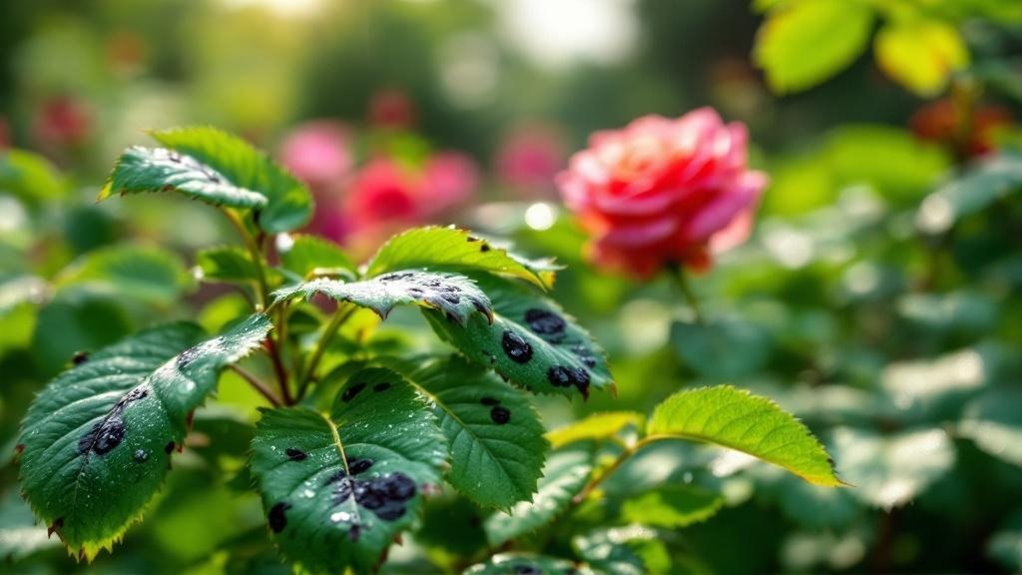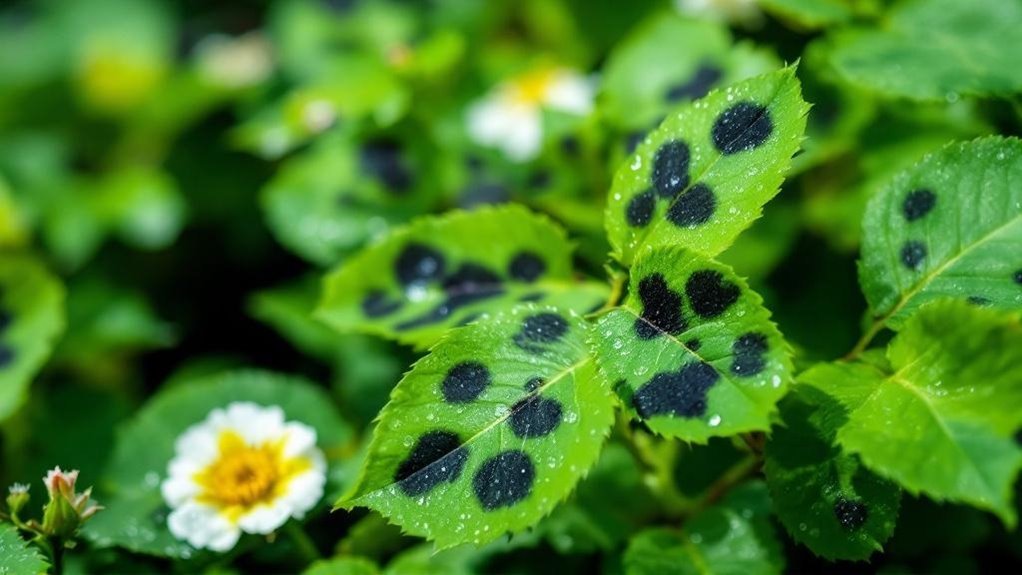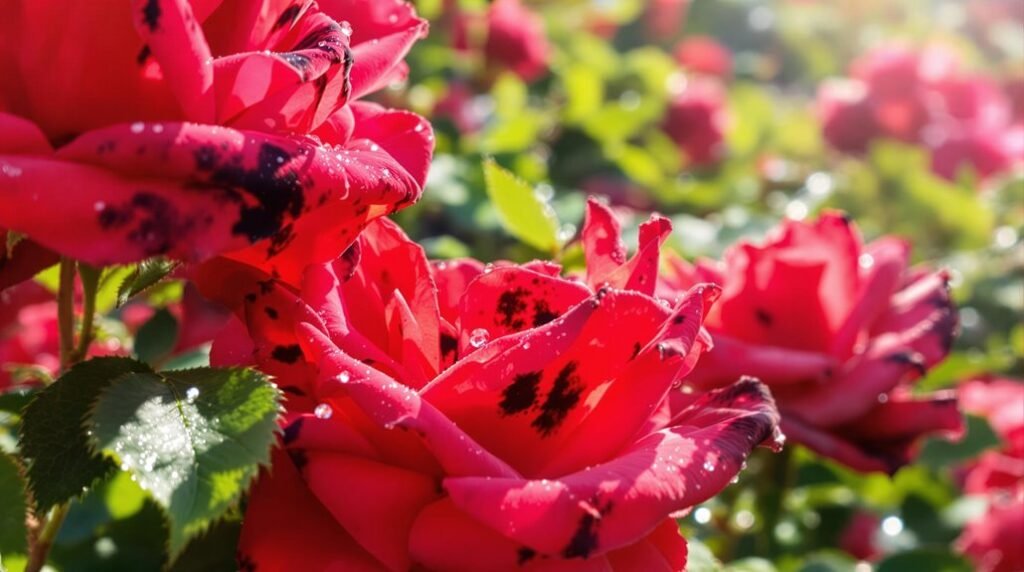You might not realize that black spot on roses can spread just from water splashing onto leaves, making it harder to control than you think. If you’ve struggled with unsightly black lesions and dropping leaves, you’re not alone. Understanding how this fungus operates and the best ways to prevent and treat it can save your roses—and your patience. Let’s explore what you can do before it takes hold in your garden.
What Is Black Spot?
Black spot is a damaging fungal disease caused by Diplocarpon rosae that targets your roses, greatly reducing their vigor.
This fungal disease primarily affects the leaves, creating black or purplish spots that weaken your plants over time. While black spot doesn’t kill your roses outright, it stresses them, making them more vulnerable to other diseases and environmental challenges.
The fungus thrives in cool, moist environments, especially when leaves stay wet for many hours, often due to overhead watering or crowded plantings.
Black spot fungus flourishes in cool, damp conditions where leaves remain wet for extended periods.
Understanding that black spot is caused by Diplocarpon rosae helps you recognize the importance of managing moisture and airflow around your roses.
Symptoms of Black Spot on Roses
When you spot irregularly shaped black marks up to half an inch wide on your rose leaves, you’re likely seeing the telltale signs of black spot disease.
These black spots appear mainly on the upper leaf surface and are often surrounded by yellowing tissue. This yellow halo signals the fungal disease’s progression, which leads to premature leaf drop, starting at the plant’s base and moving upward.
If you grow susceptible cultivars, you may notice the spots merging, covering large areas of leaves, causing significant defoliation. Infected young canes can also develop raised purple-red blotches.
These symptoms become most obvious during cool, moist weather and can severely weaken your rose’s vigor and bloom potential. Recognizing these signs early helps you manage the disease effectively.
Causes and Life Cycle of Black Spot

Although it thrives in cool, moist environments, the fungus Diplocarpon rosae needs at least nine hours of leaf wetness to infect your roses.
Black spot of rose is caused by the fungus, which overwinters in diseased canes and fallen leaves. When conditions are right, fungal spores germinate and infect new leaves, especially when wet foliage persists. The life cycle repeats every 10 to 18 days, spreading rapidly.
To control black spot, you should:
- Remove all leaves and diseased canes to reduce overwintering spores
- Improve air circulation around your roses to help foliage dry faster
- Avoid overhead watering that keeps foliage wet for long periods
Understanding this cycle helps you act promptly to protect your roses from recurring infections.
How Black Spot Spreads
Since Diplocarpon rosae spores need at least nine hours of leaf wetness to germinate, managing moisture is key to preventing black spot from spreading.
The spores primarily travel through splashing water, so overhead watering can easily move them from diseased leaves to healthy ones. When you water your roses, aim to keep foliage dry to minimize infection risks. Proper water management, including watering at the base of plants, reduces spore dispersal.
Additionally, overcrowded roses with poor plant spacing create a humid environment that favors spore germination and infection. The fungus also survives winter in infected canes and fallen leaves, ready to restart the cycle in spring.
Prevention Strategies for Black Spot

To keep black spot at bay, you’ll want to plant your roses in well-drained, sunny locations that help foliage dry quickly after rain or watering.
To prevent black spot, avoid overhead watering since wet foliage encourages fungal infections. Instead, water early in the morning or use drip irrigation.
Regularly prune away crowded branches to improve air circulation and reduce humidity around leaves. Don’t forget to clear fallen leaves and any infected debris promptly to stop spores from overwintering.
Also, consider choosing disease-resistant rose varieties to lower your chances of black spot.
Key prevention steps include:
- Avoid overhead watering to minimize wet foliage
- Prune away dense growth for better airflow
- Remove fallen leaves and infected material regularly
These strategies will help you effectively prevent black spot on your roses.
Organic Methods to Manage Black Spot
Preventing black spot sets a strong foundation, but once you spot the disease, organic management can help control its spread without harsh chemicals.
Use neem oil, an effective organic fungicide, to suppress fungal diseases like black spot. Apply it as directed for best results.
Regularly remove and dispose of infected leaves and canes to prevent the spread of the fungus in your garden. Make sure to water early in the day so your foliage has time to dry, as black spot needs at least seven hours of leaf wetness to infect.
Prune and space your roses to improve air circulation, keeping foliage as dry as possible. Finally, consider planting disease-resistant rose varieties to reduce black spot occurrence and promote healthier plants.
Chemical Treatments for Black Spot
When black spot appears despite your best efforts, chemical treatments can provide effective control. Fungicides like BioAdvanced Disease Control and Bonide Fung-onil work well for home gardeners, while commercial options such as Armada 50 WDG and Captan 80 WDG are ideal for frequent application, especially in wet spring weather.
To maximize prevention and manage black spot effectively, follow these guidelines:
- Begin fungicide treatments at bud break and reapply every 7 to 14 days, especially after rain.
- Remove and dispose of infected leaves to reduce fungal spread.
- Alternate fungicides with different modes of action to prevent resistance.
Always adhere to recommended application rates and label instructions for safety and best results when using chemical treatments on your roses.
Selecting Disease-Resistant Rose Varieties
Chemical treatments can help manage black spot, but choosing disease-resistant rose varieties offers a proactive approach that reduces your reliance on fungicides.
Varieties like Oso Easy® landscape roses are bred to withstand black spot, often maintaining healthy foliage despite environmental factors that typically promote disease.
When selecting roses, consider your specific growing conditions, as resistance levels vary among cultivars. Opting for disease-resistant hybrids not only improves plant health but also lessens maintenance challenges tied to black spot.
Still, you’ll need to monitor your plants regularly since environmental factors and overall plant health can influence their vulnerability.
Best Practices for Garden Hygiene and Maintenance
Although black spot can be stubborn, maintaining good garden hygiene greatly lowers its chances of taking hold. You should remove fallen leaves and organic materials promptly to prevent overwintering spores.
Prune diseased canes early in spring before new growth begins, disinfecting tools to avoid spreading the fungus. Avoid wet foliage by watering at the base, especially as summer heat approaches, since moisture encourages black spot.
Proper spacing improves air circulation and reduces humidity, minimizing leaf loss. Focus on these key practices:
- Clear debris to reduce fungal reservoirs
- Prune infected stems before growth begins
- Water at soil level, not overhead, to keep leaves dry
Frequently Asked Questions
How to Prevent Black Spots on Roses?
You can prevent black spots on roses by spacing plants for airflow, watering early to keep leaves dry, removing infected debris promptly, planting in sunny spots, and choosing disease-resistant varieties to keep your roses healthy and vibrant.
What Spray Do You Use for Black Spots on Roses?
You’ll see healthy green leaves contrast sharply with black spots when untreated. Use fungicides like BioAdvanced or organic neem oil, spraying thoroughly every 7–14 days. Rotate sprays to avoid resistance and keep roses vibrant.
Does Neem Oil Prevent Black Spots on Roses?
Yes, neem oil can help prevent black spots on roses by disrupting the fungus life cycle. You should apply it every 7 to 14 days, especially in wet weather, for best preventive results.
Does Soapy Water Get Rid of Black Spots on Roses?
You won’t blast black spots off roses with soapy water alone—it’s no miracle cure! But it’ll help keep leaves clean and pests down. For real results, you’ll need stronger treatments and good garden habits.
Final Thoughts
You can’t let black spot take over your roses—think of it as a shadow you need to chase away with sunlight and care. By planting in sunny spots, pruning regularly, and choosing resistant varieties, you create a fortress against this fungal foe. Combine organic treatments like neem oil with timely fungicide applications, and you’ll keep your roses blooming beautifully. Remember, a vigilant gardener is the rose’s best defense against black spot’s relentless attack.
